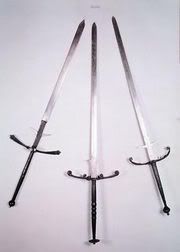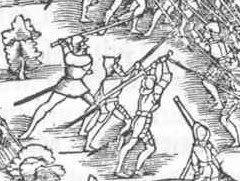
Bihänder
From Wikipedia, the free encyclopedia
(Redirected from Zweihander)
Jump to: navigation, search
16th century zweihanders, image (c) John Clements.
Enlarge
16th century zweihanders, image (c) John Clements.
The Zweihänder (help·info) (German for "two hander", also called Bidenhänder or Bihänder), is a massive two-handed sword, designed to capitalize on brute force and shock effect, at the expense of finesse.
While implemented in Germany in the 14th century[citation needed], it gained renown during the 16th century as the hallmark weapon of the German Landsknechts from the time of Maximilian I. They were allegedly used by the front lines of the Landsknechte, where they would be used to hew through the opposing pikemen and spearmen whose spears presented a difficult barrier for normal weapons and cavalry.
The zweihänder could be up to 6 feet (1.8 m) long from the base of the pommel to the tip of the blade, with a 4 to 5 foot (1.2 to 1.5 m) blade and 1 to 1½ foot (30 to 46 cm) hilt. The weight could range between 2.8 and 5 kg.
Some were shorter, though. Earlier versions in particular often had an overall length of about 5 feet (1.5 m), weighing in at as little as 1.5 kg.
Guards could be plain or ornate, while hilts usually ended with heart or pear shaped heavy pommels. When it originally debuted, in the 14th century, the construction was very similar to that of a scaled up longsword.
Occasionally a blunted portion of the forte, the ricasso (often covered with leather) at the base of the blade allowed a hand to be placed above the upper guard to "shorten the grip" and make the weapon faster. By the 16th century a second smaller upper guard was forged into the blade rather than the hilt, to protect this hand hold.
Two-handed swords made for combat use are actually quite light, often between 3 and 5 pounds, while ceremonial zweihanders weighed up to 16 pounds. Even so, with the mass distributed over a length of close to two metres, effective use would have required considerable strength. The swords have hilt-mounted side-rings and enlarged cross-guards of up to 30 centimeters (12 inches) across. Along the blade, some 10 to 20 centimeters (4–8 inches) from the upper guard, Parierhaken ("parrying hooks") shaped like lugs or flanges acted as a guard for the ricasso to prevent other weapons from sliding down the blade. These could be used in the attack of an opponent.
[edit]

Application
1548 depiction of a Zweihänder used against pikes in the Battle of Kappel.
Enlarge
1548 depiction of a Zweihänder used against pikes in the Battle of Kappel.
According to post-medieval accounts, the earlier, more practical zweihänder types were used to break up pike formations, first by smashing the pikes and then by hitting the pikemen themselves. Other longer versions of the sword were used to take the front legs off a steed in combat[citation needed].
Some scholars suggest that this is a latter-day legend, and that the type was mainly used for display. But at least as a legend, the notion appears to date to at least the 17th, if not the late 16th century: Cesare d'Evoli in 1583 discusses the impossibility of cutting pikes with a halbert and also dismisses the Zweihänder as a useless weapon. A fanciful depiction of a Zweihänder used against a halbert in a battle line appears in a Polish chronicle dated to 1597. [1]
Soldiers trained in the use of the sword (the title Meister des langen Schwertes was granted by the Marx brotherhood) earned twice the pay of a common footman and were called "Doppelsöldner".
The Doppelsöldner were often used as guards of artillery batteries. Some zweihänders were so large that they became practically unusable. These bigger, later zweihänders were mostly used for ceremonies; many do not even have proper edges.
The "Goliath fechtbuch" (1510) [2] shows fencing with zweihander sized swords, albeit without the ornamental hooks. A zweihander measuring more than 2 meters, weighing more than 6 kg, is exhibited in Leeuwarden as the sword of Pier Gerlofs Donia.
[edit]
References
* Arnold, Thomas. The Renaissance at War. London: Cassell, 2003. ISBN 0304363537.
* Miller, Douglas. Landsknechte 1486–1560. Sankt Augustin, Germany: Siegler, 2004. ISBN 3877486363. (In German.)
* Miller, Douglas, and Gerry Embleton (illustrator). The Landsknechts. Oxford, England: Osprey Publishing, 1976. ISBN 0850452589.
* Richards, John Harald, and Gerry Embleton (illustrator). Landsknecht Soldier 1486–1560. Oxford, England: Osprey Publishing, 2002. ISBN 1841762431.













No comments:
Post a Comment